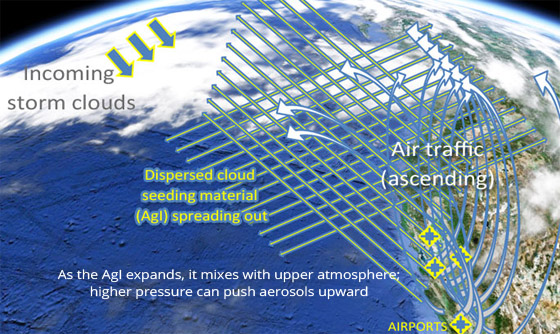It's true that jet airplanes are larger, have more powerful engines and fly more frequently than ever... about 700 million passenger flights per year in the US alone.
For each gallon of jet fuel burned, aircraft produce a gallon of water, because H2O is one of the two chemical byproducts resulting from the combustion of hydrocarbons. Current jet fuel use is about 60 billion gallons per year, so that's also about 60 billion gallons of water being manufactured in the atmoshphere annually, or nearly half a trillion pounds of H2O ... frozen water vapor that doesn't just fall back down to Earth.
In the low air pressure, sub-zero temperatures where contrails form, steam from the exhaust freezes immediately and expands to a much greater area than its sea-level volume. Since the steam is gaseous and warmer than the environment around it, it continues to rise rather than fall. 60 billion gallons of fuel = 60 billion gallons of water = approximately 10 to 20 trillion cubic feet of ice crystal clouds added to the atmosphere every year, most of which is injected into the northern hemisphere of the planet.
But there's more to artificial clouds than just frozen H2O.
2. Weather modification programs affect contrail cloud formation.
Weather modification means cloud seeding with silver iodide (AgI)— hygroscopic metallic aerosols that provide a dense field of cloud condensation nuclei (CCNs) to thicken clouds and induce precipitation. Condensation nuclei are the basis of cloud development. When mixed with moisture, silver iodide promotes cloud formation by providing CCNs that jet exhaust moisture can bond with. The invisible cloud-seeding chemicals are dispersed in the atmosphere at around 20,000 feet, in front of incoming moisture fronts, enhancing contrails from jet air traffic and often spawning cloud cover prior to the storm's arrival.
Silver iodide aerosols are invisible once dispersed, and the contrails from the planes burning the flares are minimal and usually disappear because these are small jets that are already at their cruising altitude; that is, using relatively little fuel. However, when large aircraft ascend through the seeded fields of silver iodide at these higher altitudes, their contrails become instantly visible. The extreme photosensitivity of the crystalline-shaped silver iodide aerosols combine with the highly-reflective ice crystals from the exhaust to form bright white contrail wakes behind the plane that tend to persist rather than disperse.
3. Weather modification programs burn silver iodide flares to induce precipitation.
Weather modification companies use fleets of jets and high-altitude propeller planes that have flares fixed to the wings of the aircraft. When the flares burn, they release silver iodide, a salt-based chemical (potassium iodide and silver nitrate), which provides abundant cloud condensation nuclei to spawn and thicken clouds.
Cloud seeders ignite as many flares as possible before incoming storms in order to maximize precipitation. There are other less common applications for cloud seeding, such as breaking up hailstorms with surfactants in order to reduce damage, but precipitation enhancement is the primary reason for weather modification.



